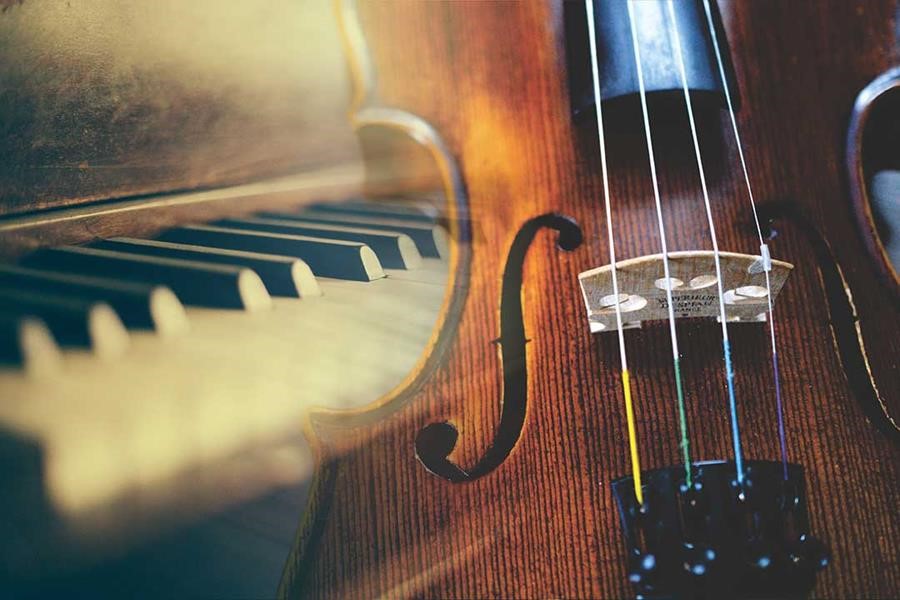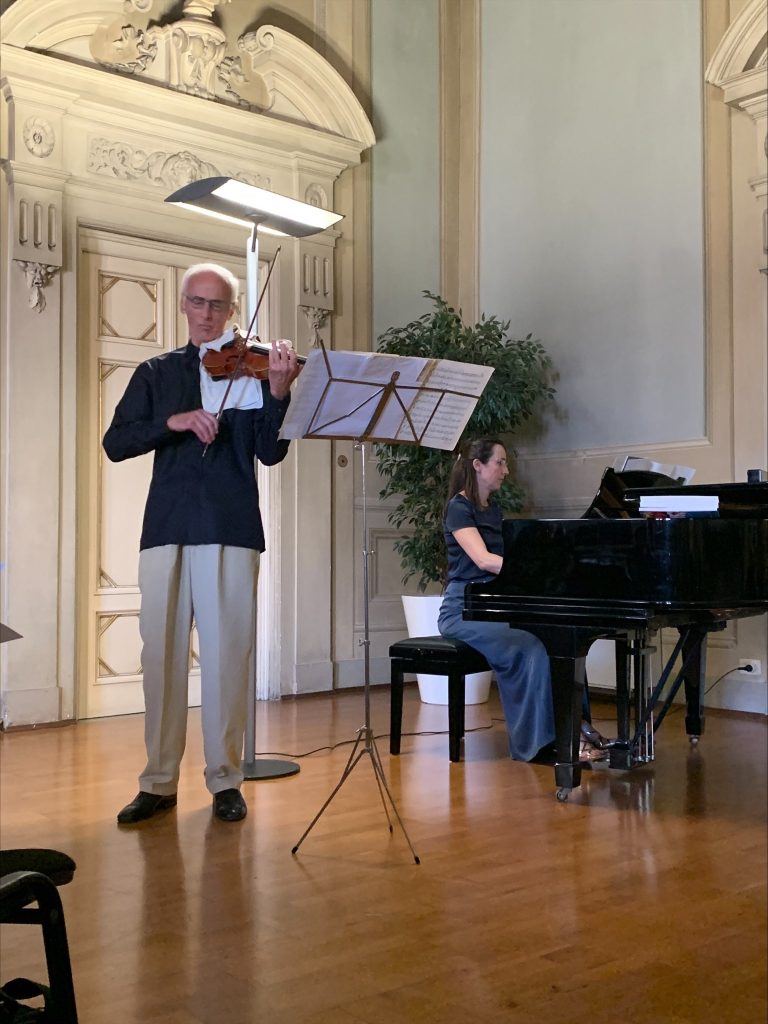Florence – June 29, 2023
Step into a world where the air is filled with anticipation and the strings of a violin resonate with the keys of a grand piano…
On the evening of June 29, 2023, Palazzo Rucellai (the ISI Florence headquarters, and a historical masterpiece in the heart of the city) played host to an unforgettable concert that left attendees mesmerized.
As the sun dipped below the horizon, casting a soft golden glow on Leon Battista Alberti’s Renaissance architecture, the hall within the palazzo became a sanctuary of harmonies and emotions. Accomplished musicians, renowned for their virtuosity, took center stage. The fusion of the violin and piano created a spellbinding synergy, weaving together melodies that seemed to transport listeners to another realm.
As the final notes of the evening resonated through the hall, a profound sense of awe and gratitude filled the air. The concert at Palazzo Rucellai on June 29, 2023, was not merely an event but an immersive experience. It served as a reminder of the transformative power of music, the universal language that unites us all, transcending barriers and connecting souls.

PROGRAM
Sonata in A major
Vivaldi-David
Preludio a Capriccio Presto
Corrente: Allegro Adagio
Giga: Allegro
Three Romances, Op. 94
Schumann
I Nicht schnell
II Einfach, innig
III Nicht schnell
Divertissement No. 1, WVa:7 – Viotti
Andante con grazia ed espressione
Romance from Sonata for Violin and Piano, Op. 82
Elgar
Andante
Theme and Variations from Sonata for Piano and Violin, K. 305
Mozart
Andante grazioso
Concert Description by Warwick Lister
Ferdinand David, a distinguished German violinist who lived more than 100 years after Vivaldi, was a friend and colleague of Mendelssohn, and he arranged a number of compositions from the Baroque period to bring them up to date, as it were. In several ways, David’s arrangement of this work bears only a distant relationship with Vivaldi’s original. For one thing, in Vivaldi’s time, the piano part would have been played on a harpsichord. For another, as was customary in Vivaldi’s time, the keyboard part in the early editions consists only of a bass line, along with a few figures indicating the harmonies—the so-called figured bass. The keyboardist was expected to fill in the harmonies, often at sight. David (as well as many others before and since) filled in the harmonies in his edition in the mid-nineteenth century style—a procedure nowadays frowned upon in the wake of the “authenticity” movement in music performance of the last thirty or forty years. Our consciences as performers and listeners may perhaps be salvaged if we think of this work as a “hybrid period piece”—at any rate irresistibly charming.
The Adagio is for all the world a dramatic operatic recitative—we are apt to forget that Vivaldi was a prolific opera composer.
Schumann’s Three Romances, Op. 94 were originally composed for oboe, but violinists tend to think that they sound quite well on the violin. Those who are familiar with the composer’s sonatas for violin and piano will recognize Schumann here at his most elusive, yet simple and heart-felt—Einfach, innig.
Viotti, Andante con grazia ed espressione, from Divertissement No. 1, WVa: 7. In 1819 Viotti published a set of three divertimenti for cello with piano accompaniment dedicated to the great cellist Jean-Louis Duport, as well as arrangements thereof for violin and piano. Duport, one of Viotti’s oldest and closest friends, died in the same year, and it may well be that Viotti, aware of his friend’s impending death, intended these lovely pieces as an affectionate homage.
The Romance by Elgar is the middle movement of his only sonata for violin and piano, composed in 1918. This piece is in three sections, having an ABA form. The first section is in Elgar’s most whimsical vein, full of fits and starts, hesitations, lingering, and just a whiff, perhaps, of Spanish rhythms, but always tender, always nostalgic. The second section rises to a passionate climax, then subsides poignantly, whereupon the whimsical music of the first section returns. There is one last, characteristic Elgarian touch: at the very end of the piece, the final quiet chord in the piano dies away, leaving the violin holding a long, sustained, lonely note.
Mozart’s early works for keyboard and violin were sonatas for harpsichord with an optional part for the violin. By the time of the present sonata, however (composed in 1778), the violin has become indispensable, though a trace of the pre-eminence of the piano remains in the first variation, which is for piano alone. That in itself should be enough to cure those who commit the horrid solecism of referring to the pianist in these works as the “accompanist.”

Natascha Majek – Bio
Born into a musical family, Natascha began to study the piano at the age of seven with Dafne Filippini-Salati in Lugano. Having attained her A-Levels in Classics, she then achieved her Bachelor of Music in Performance in less than two years at the Conservatorio della Svizzera Italiana with the Argentinian pianist Nora Doallo.
There followed three years of study for her Master’s Degree concentrating on the solo repertoire with Homero Francesch at the Musikhochschule in Zurich. During this period, she also attended chamber music lessons with Gérard Wyss at the Musikakademie in Basel.
Natascha moved to Florence in 1998 where she completed her Master’s Degree with Piernarciso Masi at the Accademia Musicale di Firenze. She then spent two years in Paris intensively studying concert performance practice at an advanced level with the Brazilian pianist Edson Elias.
Returning to Florence in 2002, Natascha worked as an accompanist at the Conservatorio della Svizzera Italiana and joined the contemporary music Ensemble Musica del 900, performing in concerts and recordings with the Radio di Lugano. During this time, she also attended masterclasses given by pianist and composer Bruno Canino in Florence.
She obtained the Master’s degree at the Istituto Superiore di Studi Musicali in Livorno with Maurizio Baglini, graduating with the highest honors and honorable mention for her thesis “Prometeo, Variazioni sul mito” (Prometheus, Variations on the Myth).
She collaborated as an orchestral pianist in such groups as the Basel Symphony Orchestra and the Orchestra Regionale Toscana and was a soloist with others including the Orchestra della Svizzera Italiana, with which she performed and recorded the Triple Concerto of Beethoven.
Natascha has performed as a soloist and in various chamber groups in concerts in Switzerland, Austria, Germany, Italy, the Philippines, and Taiwan, with a repertory ranging from Bach to the early twentieth century.
Warwick Lister – Bio
Warwick Lister is a violinist and independent researcher. For eighteen years he was a violinist in the orchestra of the Maggio Musicale Fiorentino in Florence, Italy. Previously he played in the Concertgebouw Orchestra, taught violin and music history at Ithaca College, New York, and was the second violinist of the Lenox String Quartet.
He has contributed several articles on Giovanni Battista Viotti and related subjects to scholarly publications (Music & Letters, Early Music, Eighteenth-Century Music, Ad Parnassum, The Musical Times). In 2009 his full-length biography, Amico: The Life of Giovanni Battista Viotti was published by Oxford University Press.
Mr. Lister has performed as a recitalist and chamber musician in Canada, the USA, The Netherlands, Berlin, Paris, and Florence. For several years he was the first violinist of the Musica Ricercata String Quartet in Florence. Currently, he is active in the Florence area as a chamber musician and recitalist with the pianist Natascha Majek.
